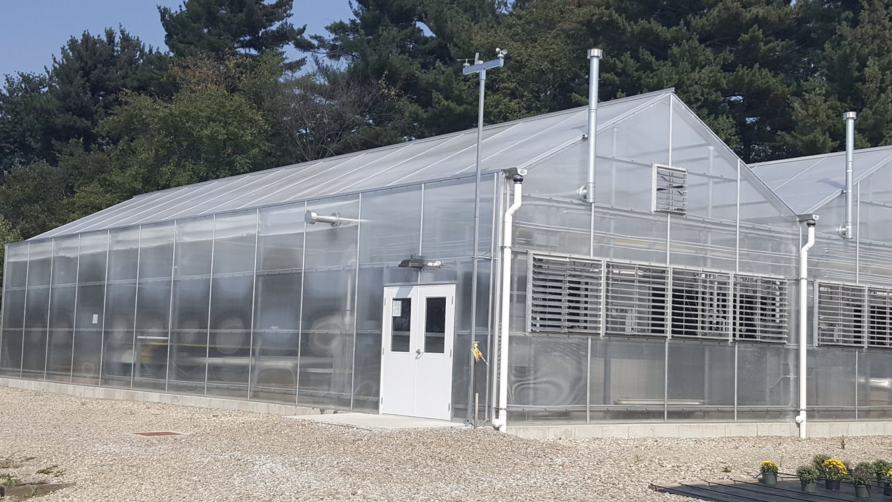Think Long Term When Considering a New Greenhouse Build Versus a Renovation

The condition of your greenhouse environment, the timing, and the cost may be the most critical factors in deciding when to build a new facility versus upgrading your current one. Photo: LLK Greenhouse Solutions
The last couple years have given many greenhouse growers the means to expand their production space, or at least make plans for it in the future. The question then often comes down to building new or upgrading your current facilities.
We reached out to a few industry suppliers to get their best advice. Here’s what they had to say.
First Questions to Answer
Paul Golden, Commercial Sales Manager, Greenhouse at Prospiant, says it’s best to look at greenhouse upgrades/renovations in terms of the changes that can be made to create the greatest marginal rate of return.
“For most growers, this is going to come down to areas that improve energy efficiency and labor efficiency, the two highest costs of operation in most cases,” Golden says. “A common mistake is to spend incremental amounts of time and money on renovations that the owners feel they can take on without looking at the larger picture of years of life left in the existing structure.”
Golden says if you’re planning to spend a significant amount of money on equipment or materials to improve your greenhouse operations, you first need to answer these questions:
- Is the greenhouse structure going to need significant upgrades in the near future?
- Is the structure the right type for the function you need?
- Will process flow be improved or will you just create a bottleneck in another area?
- Is this the best use of your money or would your returns be greater if applied in another area?
If the answer to any of the questions above gives you a reason to pause, Golden says, then perhaps a whole new purpose-built greenhouse would be a wiser and longer lasting investment for your operation.
Once you have reviewed these considerations, Golden advises to start by planning your renovations with your greenhouse manufacturer.
“If you have a challenge and need a solution, your greenhouse salesperson should be one of the first people you speak with. They will know what questions to ask and which areas to avoid pitfalls. They should be able to provide a budget and connect you with installers that specialize in this type of work. They may even be able to share a customer who has gone through the same process and can speak to the results,” Golden says.
Think Short- and Long-Term
Shawn Brown, President and CEO of LLK Greenhouse Solutions, says the condition of your greenhouse environment, the timing, and the cost may be the most critical factors in deciding when to build a new facility versus upgrading your current one.
“If you have a long season, it may be that you can’t afford to be down for an extended period of time,” Brown says. “However, one of the nice things about renovating is you may not need to deal with the permits and building codes that come with a new build. If your greenhouse has a good foundation, you can save a lot of money and time by renovating.”
Even before this, however, Brown says you need to determine the long-term goal of establishing your greenhouse environment. If there are specific changes you feel need to be made with regard to heating, ventilation, or lighting, a renovation plan may not be possible.
Of course, you could choose to both renovate and build new. This is exactly what the LLK team did when it worked with Maria Gardens Greenhouses in Ohio on its expansion plan.
“They had a goal to both renovate and build new every year. They gave us their budget, and we came up with a plan that involved adding an acre of new greenhouse space and renovating roughly the same amount,” Brown says.
Looking ahead, Brown notes two ways the industry is evolving, and how it might shape the decisions growers make on upgrading their greenhouses.
The industry is going to change drastically soon with insurability, Brown says. It’s going to become tougher to get insurance if you’re not up to local building and engineering codes, or you’re not utilizing guidelines and standards developed by groups like the National Greenhouse Manufacturers Association, he says.
Second, Brown says the next generation of growers is managing more through metrics than a hands-on approach.
“It’s a different world from 30 years ago. This next generation is studying metrics like crazy,” Brown says. “They’re not as hands-on but they are very analytical. That’s how they approach things, and we have to start approaching it like that, as well.”
Plant Performance Can Determine Need
Michael Kovalycsik, Marketing Manager at Stuppy, Inc., says the decision on when it’s time to upgrade often comes to structural appearance and performance conditions.
“Plant performance and yield would definitely be a factor in upgrading, as constant disease issues may be an indicator that some sort of equipment performance breakdown is occurring.”
On the topic of energy savings, Kovalycsik says anything from new polyethylene to heaters and exhaust fans can help.
“Simply upgrading to a new environmental control could help drastically if a unit is 10 years old,” he says of potential solutions for energy savings. “Installing energy/shade curtain systems can help with savings on heating and cooling costs, and retrofitting poly roof vents for passive cooling can lead to cost savings from running exhaust fans.”









